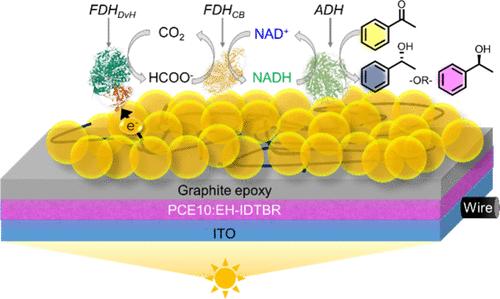半人工光电化学用于 CO2 介导的对映体选择性有机合成
IF 15.6
1区 化学
Q1 CHEMISTRY, MULTIDISCIPLINARY
引用次数: 0
摘要
光电化学(PEC)电池正处于太阳能燃料合成的密集发展阶段,但二氧化碳的减少通常只能产生简单的构建块,如HCOO -。在这里,我们证明了二氧化碳转化的PEC细胞可以通过CO2/HCOO -作为可持续的氧化还原偶对来驱动综合酶多米诺骨牌催化产生手性有机分子。首先,我们建立了一个由三种酶共同固定在高表面积电极上的半人工电极,该电极基于碳毡,由介孔氧化铟锡(ITO)涂层覆盖。当施加一个温和的阴极电位(- 0.25 V vs可逆氢电极(RHE))时,CO2被来自硝酸脱硫弧菌Hildenborough的w -甲酸脱氢酶(FDHNvH)还原为HCOO -,然后使得来自假丝酵母(Candida boidinii)的NAD+辅酶依赖性甲酸脱氢酶(FDHCB)将NAD+还原为NADH。随后,乙醇脱氢酶(ADH)利用CO2/HCOO循环产生的NADH将苯乙酮还原为手性1-苯乙醇,对映体过量(93%),转化率(38%)。根据特定的ADH (ADHS或ADHR), (S)-或(R)-1-苯乙醇可以在pH 6和20°C下合成。为了说明太阳能的利用,我们将三种纳米限制酶与基于集成有机半导体光电阴极的PEC平台集成在一起,以允许基于太阳能燃料装置的对映选择性合成(+0.8 V vs RHE)。这一原理证明表明,人工光合作用的概念和设备可以很容易地转化为精确和可持续的生物催化,包括利用光生产手性有机分子。本文章由计算机程序翻译,如有差异,请以英文原文为准。

Semiartificial Photoelectrochemistry for CO2-Mediated Enantioselective Organic Synthesis
Photoelectrochemical (PEC) cells are under intensive development for the synthesis of solar fuels, but CO2 reduction typically only results in simple building blocks such as HCOO–. Here, we demonstrate that CO2-converting PEC cells can drive integrated enzymatic domino catalysis to produce chiral organic molecules by using CO2/HCOO– as a sustainable redox couple. First, we establish a semiartificial electrode consisting of three enzymes co-immobilized on a high surface area electrode based on carbon felt covered by a mesoporous indium tin oxide (ITO) coating. When applying a mild cathodic potential (−0.25 V vs the reversible hydrogen electrode (RHE)), CO2 is reduced to HCOO– using a W-formate dehydrogenase (FDHNvH) from Nitratidesulfovibrio vulgaris Hildenborough, which then enables the reduction of NAD+ to NADH by an NAD+-cofactor-dependent formate dehydrogenase from Candida boidinii (FDHCB). Subsequently, an alcohol dehydrogenase (ADH) uses NADH generated from CO2/HCOO– cycling to reduce acetophenone to chiral 1-phenylethanol in good enantiomeric excess (93%) and conversion yields (38%). Depending on the specific ADH (ADHS or ADHR), either (S)- or (R)-1-phenylethanol can be synthesized at pH 6 and 20 °C. To illustrate solar energy utilization, we integrate the three nanoconfined enzymes with a PEC platform based on an integrated organic semiconductor photocathode to allow for enantioselective synthesis (at +0.8 V vs RHE) based on a solar fuel device. This proof-of-principle demonstration shows that concepts and devices from artificial photosynthesis can be readily translated to precise and sustainable biocatalysis, including the production of chiral organic molecules using light.
求助全文
通过发布文献求助,成功后即可免费获取论文全文。
去求助
来源期刊
CiteScore
24.40
自引率
6.00%
发文量
2398
审稿时长
1.6 months
期刊介绍:
The flagship journal of the American Chemical Society, known as the Journal of the American Chemical Society (JACS), has been a prestigious publication since its establishment in 1879. It holds a preeminent position in the field of chemistry and related interdisciplinary sciences. JACS is committed to disseminating cutting-edge research papers, covering a wide range of topics, and encompasses approximately 19,000 pages of Articles, Communications, and Perspectives annually. With a weekly publication frequency, JACS plays a vital role in advancing the field of chemistry by providing essential research.

 求助内容:
求助内容: 应助结果提醒方式:
应助结果提醒方式:


